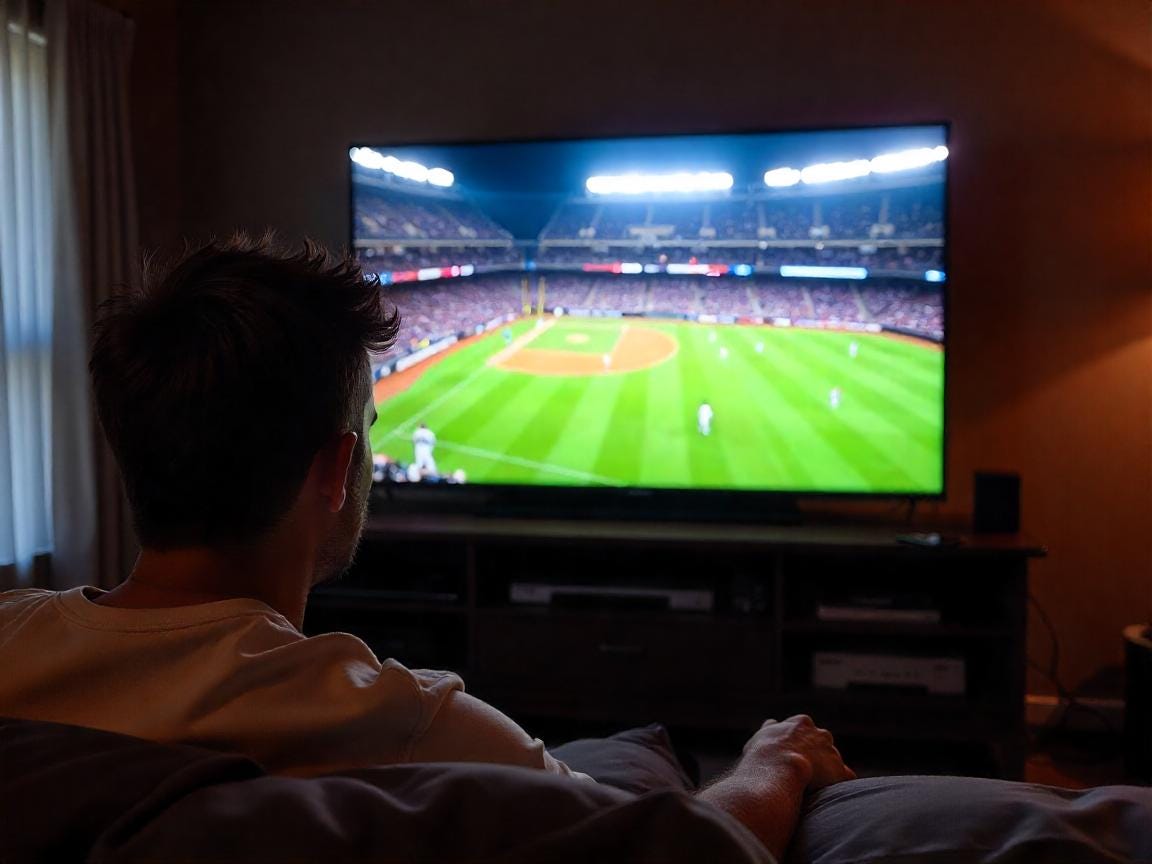Don't touch that dial!
MLB TV rights are in flux. Regional Sports Networks' struggles have hit some teams in the wallet. But baseball seems to finally understand that TV connects fans to the game.
TOP OF THE FIRST
Root, root, root for the home team
Some teams have to share more than others
The Giants and Yankees, the Yankees and Mets, the Cardinals and Browns, and the Phillies and Athletics all shared home ballparks at some point
This season the Athletics will share a park with the Class AAA Sacramento Rivercats. The Rays will be playing in a park that is the spring training home of the Yankees and the Yankees’ Florida State League affiliate.
Of course, you could argue the Rays already shared a park with the Yanks when they played at Tropicana Field.
The Rays drew about 4,000 more fans per game last season when the Yankees were the opponent. If you watched a Yankees at Rays game on TV, it sure seemed like the visiting fans were the majority at the Trop.
The Diamondbacks face a similar problem. When the Dodgers, Cubs, or Giants are in town, Chase Field usually belongs to the visiting fans.
One big difference. Unlike at Dodger Stadium, Dodgers fans at Chase tend to stay all until the end of the game.
Things must have seemed really odd for the Cubs at the beginning of this season. They opened the regular season against the Dodgers in Japan. The Cubs were technically the home team, but the crowds were overwhelmingly pulling for the Dodgers.
Then the Cubs came back and finished spring training in Mesa. Then they played their road opener, traveling 15 miles from Sloan Park to Chase Field. For once, the D-Backs seem to have a majority of the fans on their side. But it was still a pretty Cubs-friendly atmosphere.
As Dusty Baker once said of the Valley of the Sun when he was managing the Giants. “The Diamondbacks live here, but it’s a Cubs’ town.”
HEART OF THE ORDER
MLB is ready for its closeup
The demise of regional sports networks is depriving teams of a major source of revenue
The sun is setting on baseball’s Cable TV Age.
The Athletics, Giants, and Phillies became the latest teams to offer in-market streaming packages through MLB.tv. Thirteen MLB franchises have added direct-to-consumer streaming options this offseason. Twenty-seven of the 30 clubs now offer fans in local markets some streaming option.
Cord-cutting is killing off a cash cow for sports franchises, and MLB is adjusting surprisingly well and keeping fans’ interests in mind.
The transition is made easier because MLB enjoyed record-breaking revenue of $12.1 billion for 2024, representing a 4.3% increase from 2023's $11.6 billion. That came despite several teams seeing millions of dollars evaporate as their Regional Sports Networks died.
The business model with Regional Sports Networks
For lack of a better term, what I will call cable channels, such as ESPN, CNN, FOX News, MSNBC, and Lifetime, have made money in two ways for the past 30 to 40 years or so: first, selling ads, and second, charging a carriage fee to cable companies and satellite TV providers, such as DirectTV, and more recently aggregate streamers, such as YouTubeTV, Sling, or Fubo.
About half of a channel’s revenue comes from these fees and that portion appears to be rising as TV spots become tougher to sell.
For a long time, sports was a major driver of why people paid subscription TV. Knowing this, ESPN and the Regional Sports Networks charged more than other channels.
The channels charge for every subscriber to the service. So if Tom’s Cable TV has a million subscribers and carries Salt River Valley Sports and the contract calls for $3 a subscriber, Tom’s Cable pays out $3 million a month. That is paid even though most households that subscribe to Tom’s Cable TV NEVER watch the Salt River Valley Sports channel.
All this was great for local pro sports teams because most of the money paid to Regional Sports Networks went to rights fees to show the team’s games in their home market exclusively. If you signed up for the service just to get CNN and the Hallmark Channel, too bad for you.
As the monthly cost of cable started to climb and ESPN and the RSNs kept raising their asking price, cable companies tried to shift the blame for their price hikes onto the sports channels. About 20 years ago, Cox, which has the cable concession in just about the entire Phoenix metro area, tried to take a stand. But Cox quickly caved.
Cutting the cord
Then cutting the cord became a thing. Led by young people who found this a point of pride, consumers dropped cable and satellite TV providers and went with over-the-air options and/or streaming services such as Netflix.
This hit the Regional Sports Networks hard. If Tom’s Cable TV loses 100,000 subscribers, the RSN takes a $300,000 pay cut every month. And those sports channels still needed to pay the rights fees.
Something had to give. Diamond Sports Group, which carried most MLB teams’ local games, filed for bankruptcy in 2023.
That summer Diamond dropped the Diamondbacks and Padres’ TV broadcasts.
MLB took over the local rights and began offering games in Arizona and San Diego markets via streaming or a dedicated channel on a carrier. Diamond dropped the Rockies last season. And the Guardians and Twins have now joined the-MLB-clubs-without-an-RSN club.
The money
MLB’s fix still leaves the RSN-free teams without a major source of revenue.
The D-backs received about $60 million from Diamond in 2022.
To equal that amount, the D-backs would need about half the TV households in the greater Phoenix market to pony up $100 for the six-month season. That is not gonna happen.
MLB has been making up some of the shortfall through revenue sharing and “taxes” on team big-sending teams.
MLB seems to believe it can centralize local revenues, combine them with national rights packages, and make up for a large portion of the revenue that is likely to be lost.
ESPN and more
To that end, MLB exercised an opt-out of the final three years of its national rights deal with ESPN after this season. MLB is hoping to get more money. ESPN also opted out, also hoping to get a better deal.
This week the Athletic reported that MLB is considering offering its streaming service to networks and digital platforms, according to sources familiar with the discussions. This marks a significant shift for the league, which has exclusively controlled MLB.TV since its launch in August 2002. The service currently offers fans access to out-of-market games for $149.99 per season, with in-market options available for 10 teams at prices between $99.99 and $199.99 annually.
NBC, Google, YouTube, Fox. and others have expressed interest in acquiring ESPN's package. ESPN is interested in keeping it. Any new deal is expected to align with MLB's other TV contracts, which expire in 2028.
MLB.TV has seen impressive growth, with 14.5 billion minutes watched in 2024—a 14% increase from the previous season. This popularity makes it an attractive asset in the increasingly competitive streaming landscape.
For potential partners like ESPN (which is launching a direct-to-consumer service this fall), Amazon, or Apple, exclusive access to MLB.TV could provide a significant competitive advantage by offering hundreds of games to subscribers.
Suns have a better way forward
What I would really to see is teams show their games — at least some portion of their games — on local TV that is also streamable. The NBA Suns and the WNBA Mercury did that here in Arizona, making their products available to more than 2.5 million households. The Suns likely took less money for the deal (we don’t have a reported figure) but it allows them to grow their fan base.
Still, on the whole, baseball seems to be dealing with this better than I thought the sport would.
Baseball learns slowly
Going back to the days of early radio, baseball has struggled with how to share the games with those with those who don’t buy tickets. The concern was if you gave the game away, would it kill attendance?
Play-by-play radio dates back to the early 1920s. But from 1932 through 1938, the three New York teams agreed not to broadcast their games.
Eventually, baseball saw radio as a way to grow its audience.
Initially, baseball embraced local TV as a way to sell the local team.
However, the Giants and Dodgers felt local TV broadcasts of their games killed attendance in New York and kept their teams mostly off the local airwaves when the two teams moved to the West Coast in 1958.
From 1965 until about 1990, MLB’s main strategy for national TV seemed to be limiting the number of national telecasts.
As cable TV became widespread and the numerous Cubs and the Braves games on superstations WGN and WTBS won fans for the game and those teams, the Lords of Baseball’s primary worry was that if superstations proliferated, they might show more baseball games. Oh, the horror!
Anyway, after 100 years or so, MLB finally seems to understand that consuming the game either by audio or video forges connections, that showing games to fans has a value to the team beyond just rights fees, that games on TV build your brand.
It’s slow progress, but it is progress.
BONUS FRAMES
A fourth-generation big leaguer?
Arizona State freshman Landon Hairston entered the weekend of April 11-13 singled with a .349 batting average and .482 on-base percentage.
Hairston is the son of Scott Hairston, who played 11 seasons in the majors. And if all goes well, Landon could become a fourth-generation major leaguer. His great-grandfather Sam Hairston, grandfather Jerry Hairtson, and uncle Jerry Hairston Jr. played in the big leagues.
Brewer mound crew runs hot and cold
What to make of the Brewers pitching? They are either terrible or great.
Milwaukee pitchers gave up a whopping 47 runs in their first four games of the season.
But they recovered and gave up 20 runs in their next eight — but that stretch that included giving up 11 runs in one game to the Reds.
ICYMI
ICYMI part 2
ICYMI 3



